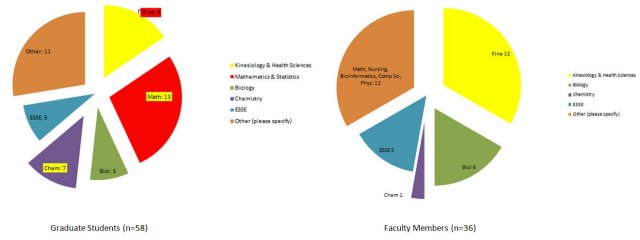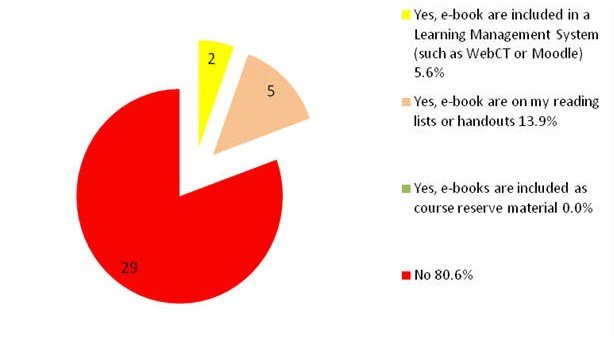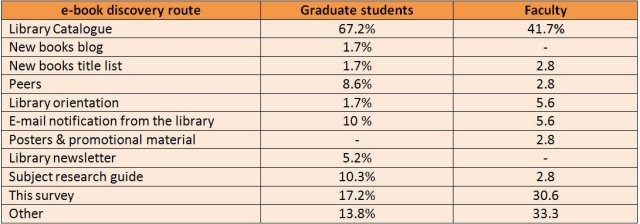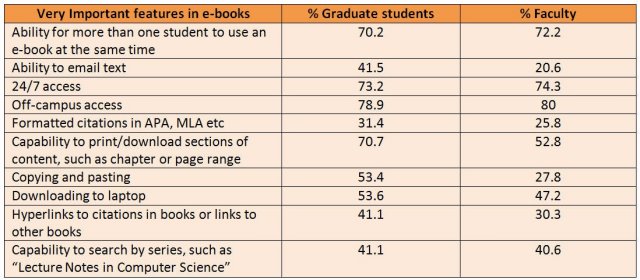| URLs in this document have been updated. Links enclosed in {curly brackets} have been changed. If a replacement link was located, the new URL was added and the link is active; if a new site could not be identified, the broken link was removed. |
E-Books in the Sciences: If We Buy It Will They Use It?
Science Librarian
Steacie Science & Engineering Library
York University Libraries
Toronto, Ontario
rajivn@yorku.ca
Introduction
York University, Toronto, Canada has been acquiring e-books from different publishers and content providers. At present our University subscribes to electronic content from NetLibrary, ebrary, EBL, Oxford Scholarship Online, Oxford Reference Online, MyiLibrary, Safari, Springer, Oxford University Press, Knovel, Books24x7, Synthesis Engineering E-books, Books@Ovid, and some other publishers that are available through ebrary platform. As libraries divert substantial amount of their budgets for e-books, librarians need to evaluate if and how these e-books are being used in the academic environment.
Although complete figures for the growth of the market in Canada are not currently available, an analysis of electronic monograph titles held and purchased by The Canadian Association of Research Libraries (CARL) libraries demonstrates both the growing importance of e-books to CARL libraries and also the importance of libraries to the e-book market. Expenditures on electronic monographs have grown from $1,127,372 in 1999-00 to $6,048,491 in 2006-07 -- a staggering 436.5% increase. In the past year alone, CARL libraries have acquired 2,890,369 electronic monograph items. Electronic monographs currently represent approximately 13% of total monograph titles held by CARL libraries, and that number is expected to continue to grow over the next several years (Owen et al. 2008).
We conducted an online e-book survey in Fall 2008 to gather responses from science graduate students and faculty on questions related to findability and accessibility of e-books, features desired in e-books and the best avenues for promotion of e-books.
Method
The online e-book survey was administered using the Survey Monkey tool available from www.surveymonkey.com. Since September is a busy time of the year and December is an exam period, we decided to conduct the survey in October-November. The survey was kept open for one month from mid-October to mid-November in 2008. Only graduate students and faculty members were selected for this study. Our University subscribes to online encyclopedias, dictionaries, and handbooks which are being used by undergraduate students. However the scope of this study was limited with plans to follow e-book usage among undergraduate students at a later time. The survey questions for graduate students and faculty members differed slightly (Appendix 1 & Appendix 2). The survey link was e-mailed to full-time and part-time faculty members (n=250) and graduate students (n=650).
The online survey link was sent via an e-mail to Graduate Program Secretaries and they were requested to forward it to graduate students. There were no prizes or draws so it can be assumed that the participants had a genuine interest in e-books or that they had used an e-book at some time and wanted to share their experiences. The usual confidentiality part was mentioned to the participants and their e-mails were not collected as a part of the study.
The survey consisted of two set of questions; the first part was to gather information on whether the respondent had used e-books (awareness). The survey included a list of e-book publishers/content providers and participants were asked to indicate if they were aware of any of them. The second part consisted of questions that would elicit responses about features used or preferred in an e-book platform.
Results & Discussions
Population Distribution
We had a total of 94 completed responses comprising of 58 graduate students (survey participation rate 8.92%) and 36 faculty members (14.4% participation) from different departments in pure and applied sciences. The response rate was considerably more than we had expected considering that there were no incentives at the end of survey completion. Out of the 58 graduate students, 16 students (27%) were from Mathematics and Statistics, 9 students (15.5%) from Kinesiology & Health Sciences, 7 students (12%) from Chemistry, 5 students (8.6%) each from Biology and Earth Sciences and the remaining 16 (27%) were from other departments comprising of Computer Science & Engineering, Nursing, and Physics (Figure 1). The higher percentage in Mathematics could be because we have the Springer Lecture Notes in Mathematics and Lecture Notes in Computer Science (online) which are findable using the library catalogue and are heavily used by graduate students and faculty in Math & Stats and Computer Science.

Figure 1: Population distribution of participants in the e-book survey
Out of the 58 graduate students, 32 students were completing their doctorates and 26 students were completing the Masters program; only three of them were part-time graduate students. We had a higher percentage of faculty from Kinesiology & Health Sciences (37%) completing the survey, which was followed by Biology (16.7%) and Earth Science (13.9%). Faculty from Mathematics, Nursing, Bioinformatics, Computer Science & Engineering, Physics, & History of Science comprised the remaining 29% of the sample. The reason for a higher participation by Kinesiology faculty over other faculty is not known. Kinesiology faculty members are frequently sent reminders of items that are acquired by the library and there is a active communication between Kinesiology faculty members and the subject librarian.
Awareness & Usage
A majority of graduate students surveyed were aware of e-books and 76% had used them. Only 44.5% of faculty members used e-books with half of those surveyed being aware of York University's e-book subscriptions (Table 1).

Table 1: Percentage who answered Yes
Although more than 50% of the faculty were aware of the availability of e-books, only 20% of faculty encouraged their use (Table 1). Faculty members were not actively promoting e-books to students and they wanted more information before recommending e-books. They were not sure if all students would be allowed concurrent access to an e-book for an unlimited amount of time. They had questions related to 24/7 access policy, copyright, and downloading issues. Faculty members were not aware of the availability of electronic content in their subjects. Other faculty presumed that the library did not have enough e-books in their subjects.
Bennett and Landoni (2005) reported that 46% of their respondents were not aware that there were e-book holdings in the library. Abdullah and Gibb's (2008) survey indicated that 72% of the participants from the University of Strathclyde were familiar with e-books while 57% said that they were not aware of the e-books from the library.

Figure 2: Faculty response: Do you recommend e-books to your students?
Book Discovery Process
The Library catalogue remains the most popular way to find e-books. (Table 2).

Table 2: How do you usually find and access E-books?
Two faculty members commented (those who selected Other) that they were using Google Scholar and NCBI bookshelf to access health science e-books. A small percentage also browsed the new book title list on the library home page or relied on discussions with colleagues (Table 2). A significant number of faculty and students replied that they came to know about subscribed e-books packages from this survey and that they planned to use e-books after the survey.
Abdullah and Gibb's (2008) e-book survey found that 54% of the students accessed e-books from the library web site. Bennett and Landoni (2005) have also suggested that every effort should be made to include e-books in the catalogue to promote e-book usage in academic libraries.
Online Reading Habits
Faculty members don't spend much time reading e-books on the screen; only 22% of them spent more than 20 minutes reading material on the screen and 44% of them responded that they never read a book online (those replying Other). A faculty member said that it was easier to print and read at leisure (Table 3).

Table 3: In a typical session, how long do you spend reading an e-book from the screen?
The results were markedly different for graduate students where 41.4% had spent more than 20 minutes reading a book online (Table 3).

Table 4: How much of that e-book did you read online in one sitting? (subset of the respondents who answered the previous question)
Only 16.7% of the faculty said that they had read several chapters, 33.3% of the faculty read less than one chapter, and 36% had browsed through the book (Table 4). The results in Table 4 are a subset of the respondents who read e-books online (Table 3). Similarly for graduate students: 36.2% had read less than one chapter in one sitting, 29.3% had browsed through the book, and 19% had read several chapters. None of the faculty members had read a whole book while two graduate students had read the whole book in one session. Physics and computer science students said that they preferred having the book chapter printed which would give them an opportunity to write and then discuss relevant points with their colleagues. This was indicated by the students in comments section at the end of the survey.
Levine-Clark (2006) reported that 47.9% of the faculty tend to read a chapter or article or a single entry/few pages (42.5%) instead of reading an entire e-book (9.6%). In their study, students and faculty commented that eyestrain was one of the reasons why print books were preferred over e-books. In ebrary's faculty survey (2007), 79% of the faculty stated that they preferred the portability of print books when they were reading the entire book or extensive sections in it.
E-book Packages Used
E-books that have been catalogued and are findable through the library catalogue had the highest usage statistics. The Springer series were ranked higher in terms of usage (Table 5), since a higher percentage of students in our survey were from Mathematics and Statistics (Figure 1). The MARC records of Springer e-books are included in the library catalogue.

Table 5: Top used e-book packages
Our survey results show that students are aware and use online reference material. Around 12.1% of them had used online resources such as Encyclopedia Britannica (12.1%), Oxford Reference (6.9%), Wiley Encyclopedia of Life Sciences (6.9%), and CRC Handbook of Chemistry & Physics (5.2%). Similarly 8.3% of the faculty had used Encyclopedia Britannica and 11% of the faculty had used the CRC Handbook of Chemistry & Physics (Table 5).
Preferred features
Some of the very important features for faculty members and graduate students were off-campus access to e-books, ability for multiple users to read the book at the same time, 24/7 access, capability to print and download sections or chapters on their laptops, and capability to search by series.

Table 6: Very important features desired in e-book packages by graduate students and faculty
Chong & Ling (2009) reported that undergraduate and graduate students from the Multimedia University in Malaysia listed bookmarking, highlighting, and annotating as some of the most important features in an ideal e-book. Some other important features included were the ability to cross-reference between the contents and index page and the ability to search within a book.
Promoting E-books
E-book promotion needs to leverage on the convenience, searchability, and accessibility of e-books as a format. A number of faculty members commented that they were not aware of the various e-book packages and features available within them. They have suggested organizing faculty workshops and other information sessions to inform them about new e-book packages purchased by the library. Science librarians at York have been promoting e-books using the New Books blog, creating {public blogrolls} for publishers providing RSS feeds, personal communications, creating posters, and informing faculty and students at library open houses. Springer, Morgan and Claypool, and the Royal Society of Chemistry (RSC) have DOIs for books and book chapters and some science librarians have created permanent links for individual chapters that can be linked from the course reserves page.
Conclusions
The data and comments gathered from the survey indicate that e-books have not been used to a very large extent and there is room for further promotion and education. This is especially true for our faculty members who require clarifications about e-book policies and accessibility before recommending these resources. Graduate students and faculty have informed us that they would like the ability to download individual chapters. Additionally graduate students want the ability to print complete chapters without restrictions. In some cases we have the e-book available from the publisher's platform as well as from the content aggregator. It remains to be seen if the book is accessed either from the publisher's platform which allows chapter downloads and printing or from the content aggregator's site which usually does not allow downloading individual chapters and limits printing to 5-10 pages at a time. This is an area of research that can be explored in another study.
Graduate students are more aware of e-books including the content subscribed by York University Libraries. There is a marked difference in the online reading preferences of faculty and graduate students. The quantitative data from Tables 3 and 4 suggests that students spend more time reading books online whereas faculty members read specific pages or entries rather than the whole book. Two faculty members mentioned eyestrain as one of the reasons for not using e-books. It remains to be seen if reading the same book on an e-book reader would result in better uptake of e-books. This is an area for further research.
A majority of the faculty members and graduate students were using the catalogue to find e-books. If an e-book is not catalogued they may have the misperception that there are fewer e-books in their subjects. E-books that are indexed in the catalogue are more likely to be used than e-books which are promoted by e-mail and other avenues and have not been indexed in the catalogue.
Faculty and students were not aware of many value-added features that are now available through e-book platforms. Computer Science and physics graduate students said that they like the ability to write on paper and share comments with colleagues. It remains to be seen if the collaborative tools to share notes will draw students to use e-books. Librarians will need to promote these tools to the academic community.
As academic libraries increasingly turn to e-books as an alternative to purchasing multiple copies, it's important that we understand how e-books are perceived and used by our faculty. Their endorsement as well as understanding the challenges faced by our student community cannot be underestimated. Faculty mentioned about the importance of DOI in e-books and if they are provided ready-to-use DOIs or permanent links, they would link chapters or the e-book in their course reading material.
As the number of online course offerings and distance learners continues to grow at our University, we anticipate that faculty and teaching associates will increasingly face the need to find new ways of providing course materials and this demand can be met by e-books. In addition to marketing e-books to faculty and students, academic librarians have a responsibility to advocate the needs of their users to e-book vendors. They will have to address issues related to complete MARC records, digital rights management, and agree on a basic set of online searching features desired in an ideal e-book platform. These key issues will also need to be considered more so if library consortia work towards an enhanced unified e-book platform. Without the input of libraries and academic community, e-book vendors' primary clientele, there is no guarantee that the necessary improvements in usability, accessibility, and interactivity would ever be made. E-books have the potential to serve the teaching, learning, and research needs of the academia and together e-book vendors, librarians, faculty and students can enhance the adoption of this product.
Appendices
Appendix 1 - Faculty SurveyAppendix 2 - Graduate Survey
References
Abdullah, N. & Gibb, F. 2008. Students' attitudes towards e-books in a Scottish higher education institute: part 1. Library Review 57(8): 593-605.
Bennett, L. and Landoni, M. 2005. E-books in academic libraries. Electronic Library 23(1): 9-16.
Carlock, D.M. & Maughan P.A. 2008. Exploring faculty experiences with e-books: a focus group. Library Hi Tech 26(2): 244-254.
Chong, P., Lim, Y., & Ling, S. 2009. On the design preferences for ebooks. IETE Technical Review 26(3): 213-222. [Online]. Available: {http://dx.doi.org/10.4103/0256-4602.50706} [Accessed October 19, 2009].
ebrary. 2007. 2007 Global Faculty E-book Survey Sponsored by ebrary. [Online]. Available: {http://www.calvin.edu/~dsc8/documents/ebrary_faculty_survey_2007.pdf} [Accessed March 3, 2009].
Levine-Clark, M. 2006. Electronic book usage: a survey at the University of Denver. Portal: Libraries and the Academy 6(3): 285-299. [Online]. Available: http://muse.jhu.edu/journals/portal_libraries_and_the_academy/v006/6.3levine-clark.pdf [Accessed October 19, 2009].
Owen, V., Tiessen, R., Weir, L., DesRoches, D., & Noel, W. 2008. E-books in Research Libraries: Issues of Access and Use. Unpublished manuscript. [Online]. Available: {http://web.archive.org/web/20090203184228/http://www.carl-abrc.ca/projects/copyright/pdf/CARL%20E-Book%20Report-e.doc} [Accessed March 24, 2009].
| Previous | Contents | Next |
